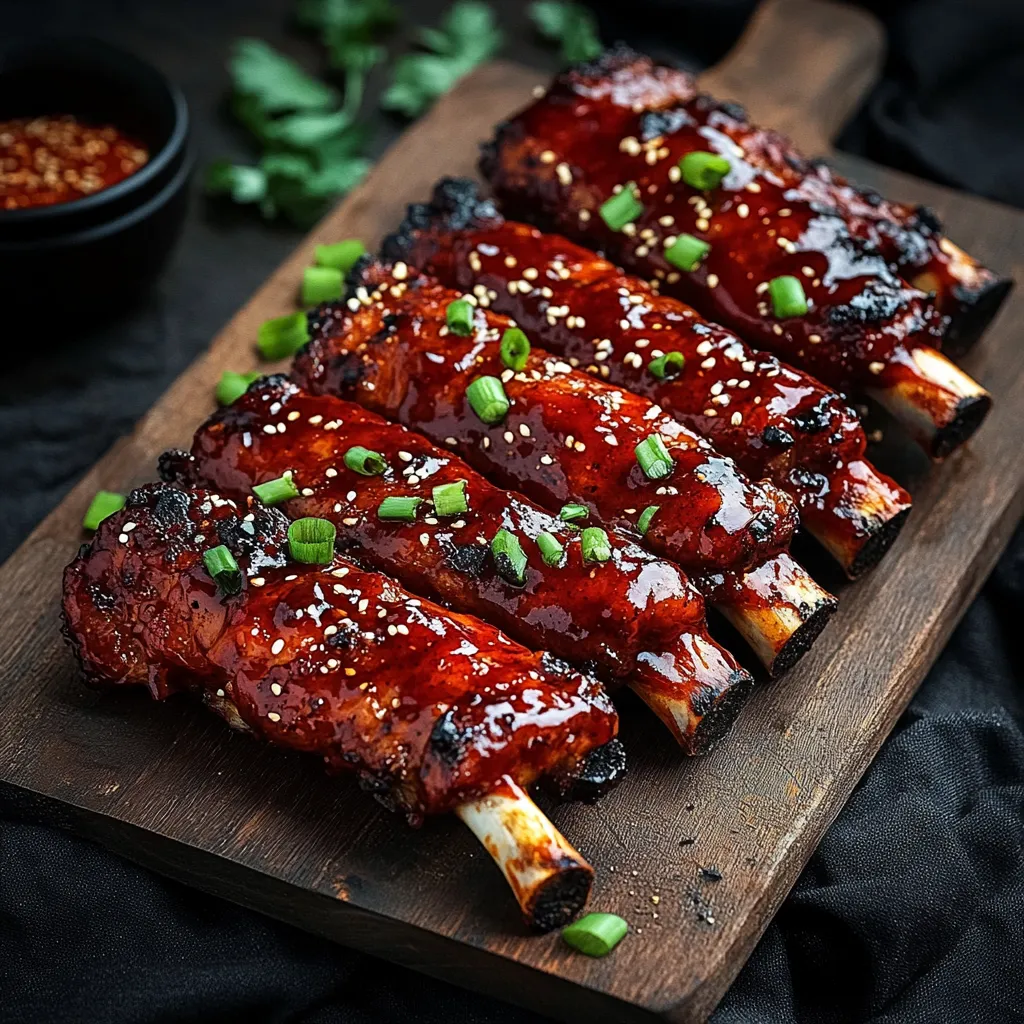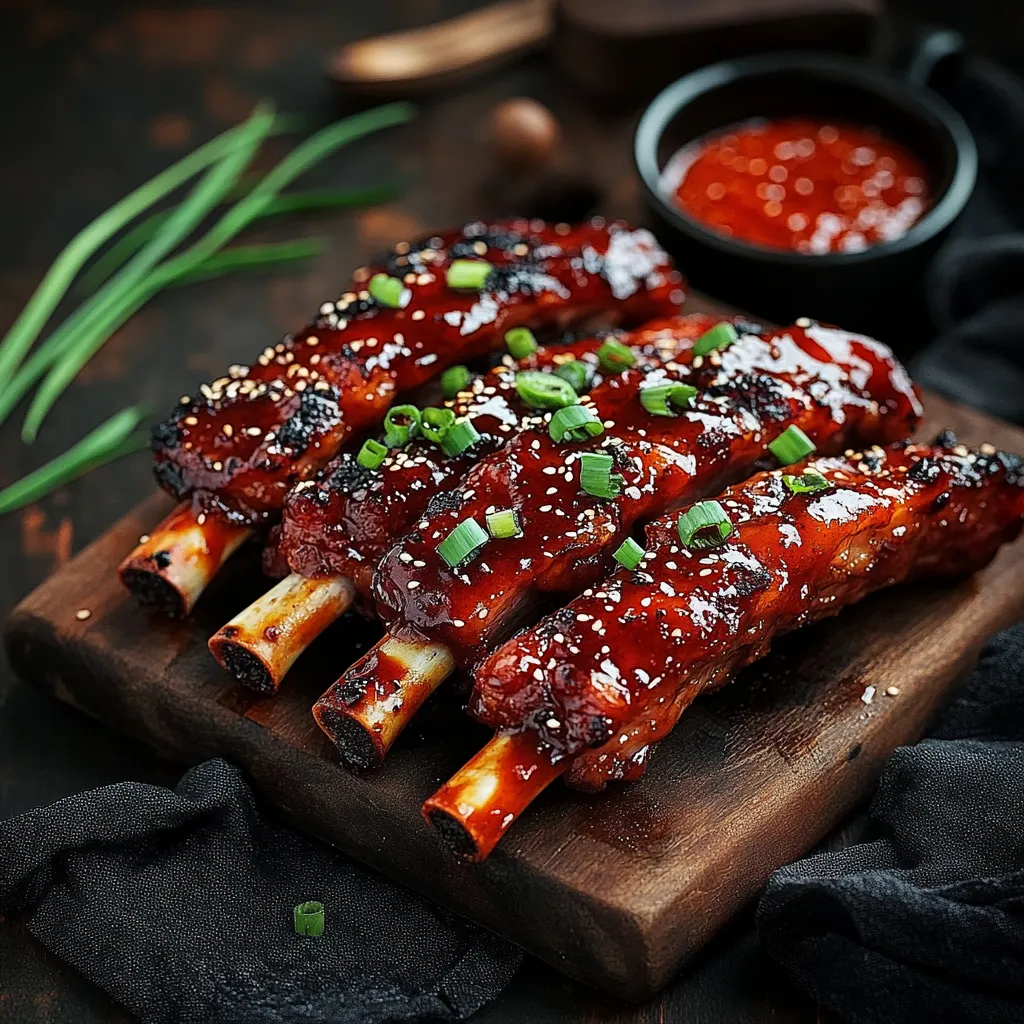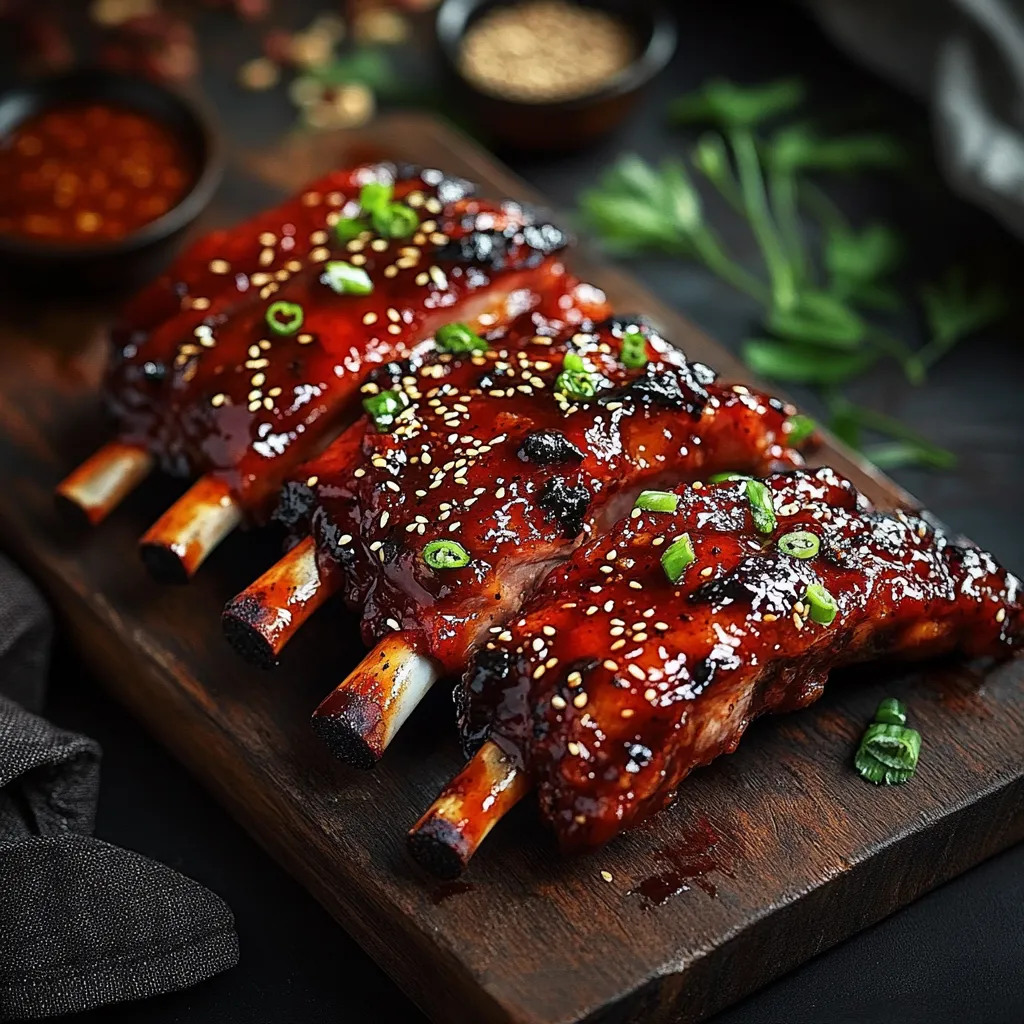 Pin it
Pin it
Sticky-sweet, smoky, and perfectly spicy, these Gochujang Glazed Pork Ribs have become my go-to centerpiece whenever I want to wow friends or family. The deep flavors of Korean chili paste in the glaze bring a mouthwatering twist to classic ribs, while the fall-off-the-bone texture keeps everyone reaching for another piece.
First time I made these, I worried the spice might be too much, but my family devoured every bite and now these ribs are requested for every special occasion.
Ingredients
- Pork ribs: Opt for baby back or St. Louis style; they deliver juicy and tender results
- Salt: Essential for seasoning and tenderizing
- Black pepper: Brings mild heat and depth
- Garlic powder: Gives subtle savory backbone; look for granulated for best adhesion
- Smoked paprika: Infuses gentle smokiness; opt for Spanish smoked if possible
- Gochujang: Korean chili paste is the star; go for one labeled medium heat for versatile flavor
- Honey or brown sugar: For caramelization and a glossy finish; choose local honey if you can
- Soy sauce or tamari: Builds umami richness; select low sodium to control saltiness
- Rice vinegar: Brings brightness and balances the heat
- Sesame oil: Intensifies the glaze’s aroma; use toasted sesame oil for a nutty flavor
- Fresh ginger and garlic: These aromatics wake up the glaze; use fresh for best punch
- Sesame seeds and green onions: For garnish; add crunch and a pop of freshness
- Look for ribs with good marbling and minimal surface fat for juicy results. Always choose gochujang that lists chili, fermented soybeans, and rice for full flavor.
Step-by-Step Instructions
- Prepare the Ribs:
- Remove the membrane. Slip a blunt knife beneath the membrane on the back of each rack and gently peel away the thin silver skin using a paper towel for grip. This step ensures your ribs are meltingly tender after cooking.
- Season the Ribs:
- Blend salt, black pepper, garlic powder, and smoked paprika in a bowl. Rub this mixture generously over the ribs, making sure every surface is coated. Press firmly so the spice mix sticks. This layer starts building that craveable barbecue flavor.
- Pre-Cook the Ribs:
- Oven Method: Heat oven to 300 degrees Fahrenheit and wrap each rack tightly in foil. Set on a baking sheet and bake for two and a half to three hours, until a fork easily pierces the meat. This slow cook melts connective tissue for exceptional tenderness.
- Grill Method: Heat your grill to medium-low and wrap ribs in foil. Place on the grates and cook covered for two and a half to three hours, turning every forty minutes so they cook evenly. The low indirect heat does all the work for you.
- Make the Gochujang Glaze:
- Combine all glaze ingredients in a small saucepan: gochujang, honey, soy sauce, rice vinegar, sesame oil, ginger, and garlic. Whisk until smooth.
- Simmer the Glaze:
- Warm the saucepan over medium-low heat. Stir often and keep an eye as it thickens slightly after about five minutes. Letting it gently bubble melds the flavors and creates a silky shine.
- Glaze and Finish the Ribs:
- Once the ribs are tender, take them out of the foil. Use a brush to lavish them with the gochujang glaze on all sides. Take your time to build an even coating; this is where all the flavor happens.
- Caramelize the Glaze:
- For broiling, set oven to high and arrange ribs on a foil-lined tray. Broil for three to five minutes, watching closely for a gorgeous deep red char. For grilling, put the ribs glaze side down over medium-high heat for two to three minutes, then flip and repeat. This creates sticky, caramelized edges.
- Serve and Garnish:
- Move ribs to a cutting board. Slice between each bone for even pieces. Sprinkle on sesame seeds and green onions just before serving to add crunch and a fresh look.
 Pin it
Pin it
I am always amazed by how the smokiness of the paprika and the punch of fresh ginger work together. Nothing beats the moment we gather around the table, laughing and licking every bit of glaze from our fingers. It never fails to bring everyone a little closer.
Storage Tips
These ribs keep well in the fridge for up to four days. Wrap tightly in foil or store in an airtight container. For longer storage, you can freeze tightly wrapped ribs for up to two months and reheat in a covered baking dish at 300 degrees Fahrenheit until hot. The glaze actually deepens in flavor overnight, so save a few pieces for future meals.
Ingredient Substitutions
No gochujang on hand? Try sambal oelek plus a teaspoon of miso paste for a tangy alternative. If you are out of rice vinegar, a splash of apple cider vinegar works nicely. To keep it gluten-free, use tamari in place of soy sauce and double-check all other labels. Brown sugar can swap in for honey and still give you an amazing glaze.
Serving Suggestions
These ribs love being the highlight of any table. Pair with fluffy steamed rice or a cool cucumber salad for contrast. Grilled corn or Korean-style slaw add crunch and color. For a complete meal, I like to offer simple pickled vegetables and chilled beer to offset the spice.
 Pin it
Pin it
Trying this recipe never fails to spark talk around the table, with everyone fighting for the last sticky piece. Prepare extra if you want leftovers, because these ribs vanish fast.
Frequently Asked Questions
- → What type of pork ribs work best?
Baby back or St. Louis-style ribs deliver tender results and absorb the bold glaze beautifully.
- → How do I ensure the ribs are extra tender?
Removing the membrane and slow-cooking wrapped in foil helps break down tough fibers for a melt-in-your-mouth texture.
- → Can I adjust the glaze's spiciness?
Yes, reduce the gochujang for milder heat or add extra honey or brown sugar for balance.
- → Is the recipe gluten-free?
Use tamari instead of soy sauce to keep the glaze gluten-free.
- → What's the best way to caramelize the glaze?
Broil the ribs or grill over direct heat for a few minutes, watching closely to avoid burning.
- → Can I prepare the ribs ahead of time?
Yes, slow-cook the ribs in advance and glaze them just before serving for best flavor and texture.
